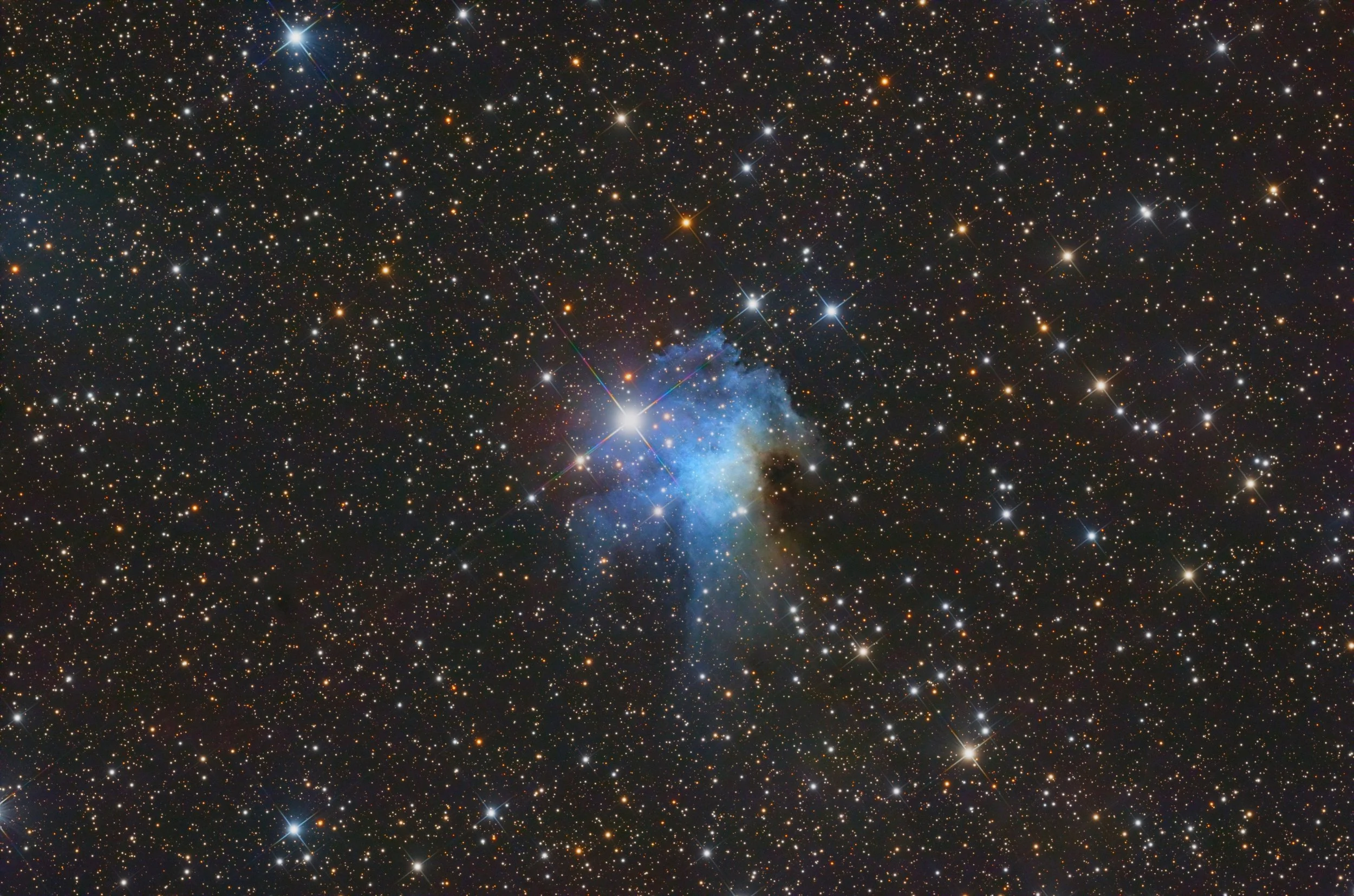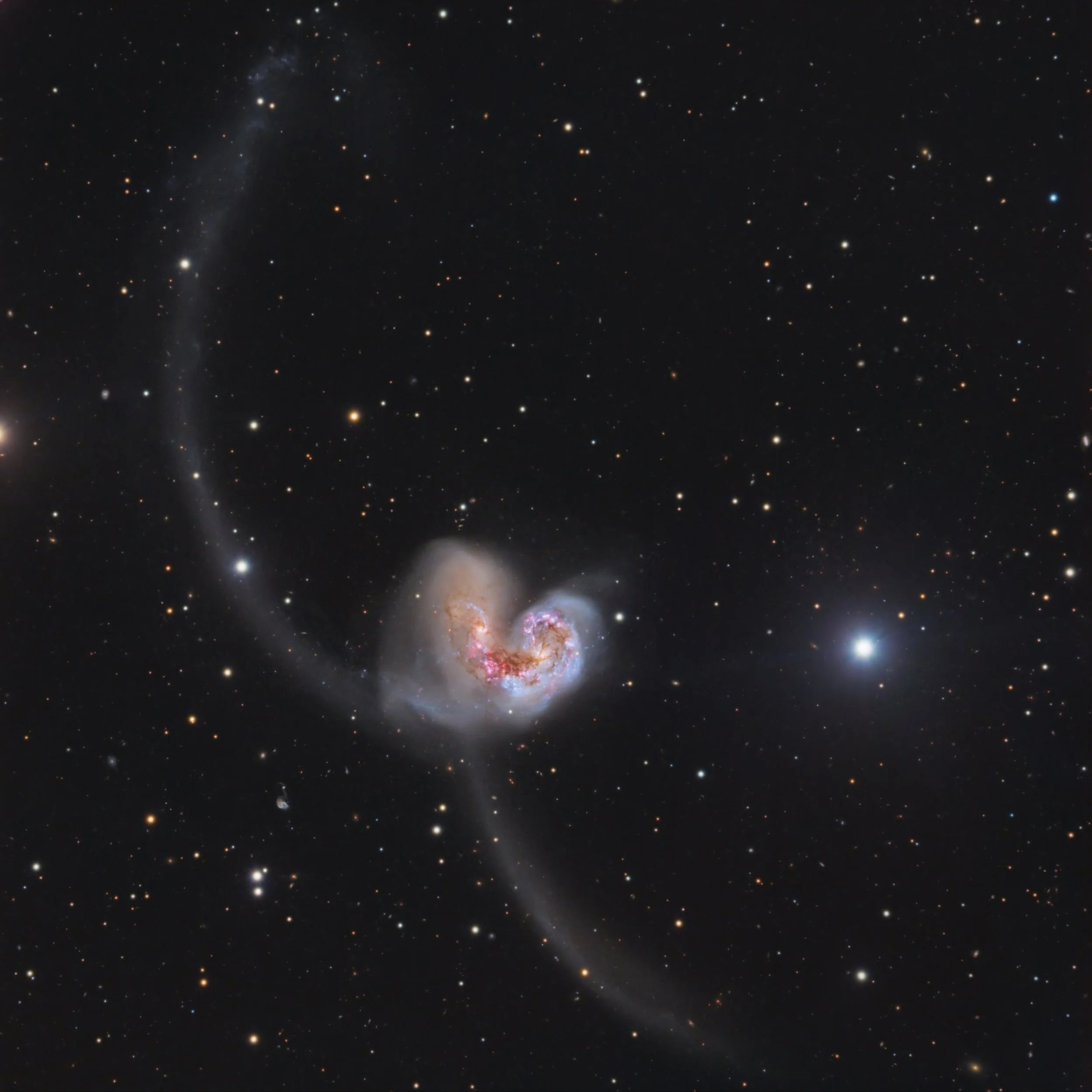
AAPOD2 Image Archives
IC-5076 LRGB
IC 5076 is a reflection nebula located in the constellation Cygnus, about 2,000 light-years from Earth. This nebula shines due to the light from nearby stars reflecting off its dust particles, rather than emitting light on its own. IC 5076 is surrounded by a rich star field typical of this region of the Milky Way, contributing to its striking appearance.
The LRGB imaging technique used here combines luminance (L) with red (R), green (G), and blue (B) color data to produce a vibrant, detailed image. The reflection nebula appears as a faint, bluish cloud, contrasting with the brighter stars that populate the background. The interplay between the dust and the starlight creates an ethereal view, highlighting the delicate structures within IC 5076.
LDN673 Dark nebula
LDN 673 is a striking dark nebula located in the constellation Aquila, approximately 600 light-years away from Earth. This region of space is rich with dense molecular clouds, where interstellar dust blocks the light from the stars behind it, creating a dark silhouette against the backdrop of the Milky Way. LDN 673 is part of a larger complex known as the Aquila Rift, an area of intense star formation activity.
In this image, the intricate patterns of the dark nebula are beautifully contrasted with the dense star field surrounding it. The thick clouds of dust and gas are where new stars are born, and their dark, winding shapes create a mesmerizing view. Despite the challenging nature of imaging such faint objects, this photograph captures the mysterious beauty of LDN 673, offering a glimpse into the dynamic processes that govern star formation in our galaxy.
ShaRA#9 – The Antennaee Galaxies
The Antennae Galaxies (NGC 4038 and NGC 4039) are a pair of interacting galaxies located about 45 million light-years away in the constellation Corvus. These galaxies are named for the long, antenna-like tidal tails of stars and gas that extend from the galactic cores, resulting from their dramatic collision and merging process. The Antennae Galaxies are in the midst of a significant starburst event, where the interaction has triggered the formation of millions of new stars, visible as bright blue clusters scattered throughout the galaxies.
This image of the Antennae Galaxies captures the chaotic beauty of the ongoing cosmic collision, highlighting the vibrant star-forming regions and the intricate tidal tails stretching into space. Although amateur astrophotography equipment may not match the resolution and detail of images taken by space telescopes like Hubble, the dedication and skill of amateur astronomers bring the wonder of these distant galaxies closer to home. The contrast between the dense galactic cores and the ethereal tidal streams showcases the dynamic and ever-evolving nature of the universe.
Mystical Heart of the Eagle
The Eagle Nebula, also known as Messier 16 (M16), is a young open cluster of stars in the constellation Serpens. Located about 7,000 light-years from Earth, this region is famous for its towering pillars of gas and dust, which are the birthplace of new stars. These iconic structures, known as the "Pillars of Creation," were famously imaged by the Hubble Space Telescope and are one of the most recognized features in the universe.
This amateur photo of the Eagle Nebula captures the ethereal beauty and intricate details of the region, showcasing the vibrant colors and delicate structures of the gas and dust clouds. While it may not achieve the same level of resolution and depth as the Hubble version, this image still provides a stunning view of the nebula's majesty. The amateur capture highlights the accessibility of astrophotography to enthusiasts and the ability to contribute meaningful observations, even in comparison to professional space telescopes.
Messier 39
Messier 39 (M39) is a beautiful open cluster located in the constellation Cygnus, the Swan. Situated approximately 800 light-years from Earth, this cluster is relatively close in astronomical terms. M39 is easily visible to the naked eye under dark skies and appears as a large, loose grouping of stars, covering an area about the size of the full moon.
This cluster consists of around 30 bright stars, most of which are blue-white in color, indicating their young age. Estimated to be around 300 million years old, M39 offers a stunning spectacle when observed through binoculars or a small telescope. The stars of M39 are spread out over a wide region, giving it a sparse, scattered appearance compared to more tightly packed clusters. This open cluster is a popular target for amateur astronomers, especially during the summer months when Cygnus is prominently positioned in the northern hemisphere’s night sky.
NGC7000 IC5070 MOSAIC
This stunning mosaic captures the North America Nebula (NGC 7000) and the Pelican Nebula (IC 5070), two prominent emission nebulae in the constellation Cygnus. Located approximately 1,600 light-years from Earth, these nebulae are part of a larger region of ionized hydrogen gas (H II region), creating a vibrant and colorful display in the night sky.
The North America Nebula, named for its resemblance to the continent, features distinct regions resembling the Gulf of Mexico, the eastern seaboard, and the west coast. The Pelican Nebula, adjacent to the North America Nebula, also has a recognizable shape, resembling a pelican with its long beak and curved neck. This mosaic image, created by combining multiple frames, highlights the intricate details and structures within these nebulae, showcasing dark dust lanes, bright emission regions, and areas of active star formation.
TWILIGHTS
This collection of images captures the breathtaking beauty of Sierra del Híjar, Cantabria, as seen through the different phases of twilight and the first hours of the night. Each phase, from sunset to astronomical twilight, reveals a unique aspect of this stunning landscape.
- Sunset: As the sun dips below the horizon, the sky is painted with vibrant hues of orange, pink, and purple, casting a warm glow over the rugged terrain of Sierra del Híjar.
- Civil Twilight: The sun is just below the horizon, and the sky retains a soft, pastel light. This is when the landscape is still clearly visible, and the first stars begin to twinkle.
- Nautical Twilight: The sky darkens further, with a deepening blue that marks the transition from day to night. The brighter stars and planets become more prominent, providing a guide for navigators.
- Astronomical Twilight: The sky is almost completely dark, with the last vestiges of sunlight fading away. This phase is perfect for stargazing, as the faintest stars and distant galaxies become visible.
- First Hours of Night: Complete darkness envelops the landscape, allowing the full splendor of the night sky to unfold. The Milky Way stretches across the heavens, and the constellations stand out in sharp relief against the dark canvas of space.
A panoramic view combining these different twilight phases offers a comprehensive visual experience, showcasing the gradual transition from day to night over the picturesque Sierra del Híjar. The serene beauty and tranquility of this natural spectacle highlight the stunning interplay of light and shadow across the landscape.
The Plasma Dance
This image of the Sun captures its current solar maximum phase, showcasing the dynamic and intense activity on its surface. The image was created by combining six days of solar prominence limb activity observed over the past two months. These prominences, which appear as bright loops and arches extending from the Sun's surface, are caused by the Sun's magnetic field and are particularly active during the solar maximum.
During a solar maximum, the Sun's magnetic field is at its strongest, leading to an increase in sunspots, solar flares, and prominences. This period of heightened activity, occurring roughly every 11 years, has a significant impact on space weather and can even affect satellite communications and power grids on Earth. This composite image provides a vivid representation of the Sun's dynamic behavior during this peak period, offering a stunning glimpse into the powerful forces at work on our closest star.
SNR G206.9+2.3 Supernova Remnant in the constellation Monoceros
SNR G206.9+2.3 is a stunning supernova remnant located in the constellation Monoceros. This image captures the intricate details and vibrant colors of the nebula, revealing the remnants of a massive star that exploded thousands of years ago. The nebula's structure is beautifully highlighted by the Ha and Oiii filters, which emphasize the regions of ionized hydrogen and oxygen, while the RGB filters add a natural color balance to the image.
Photographed at the Observatorio Remoto Desierto Cósmico in Atacama, Chile, this image benefits from the exceptionally dark skies of a Bortle 2.0 location. The total integration time of 24 hours and 15 minutes allowed for the collection of extensive data, bringing out the faintest details and the full grandeur of this celestial object. The resulting image is a testament to the beauty and complexity of supernova remnants, providing a glimpse into the life cycle of stars.











